University Nursing Report: Fall Prevention in Geriatric Care
VerifiedAdded on 2019/11/25
|11
|2653
|250
Report
AI Summary
This nursing report addresses the critical issue of falls among older adults in a hospital setting. The report begins with an introduction to practice development and the use of the Wadula puzzling cube as a tool for identifying and addressing clinical issues. The assignment focuses on the author's experience in a Melbourne hospital, where patient falls in geriatric care were a significant concern. The report outlines the purpose of the assignment, which is to determine staff preferences for fall prevention practices to achieve the goal of reducing falls and improve patient safety. The report emphasizes the importance of evidence-based practice and collaborative, inclusive, and participatory (CIP) principles. The report includes a literature review highlighting the consequences of falls, such as increased hospital stays and costs, and the challenges in implementing evidence-based fall prevention strategies. The report discusses the engagement of stakeholders, including nurses, physicians, and patients, to gain multiple perspectives on the issue. The context of the project, including the use of emails and direct communication with patients, is explained, along with the evaluation process, which involved monitoring and feedback. The report concludes by discussing the facilitation and implementation of the proposed solutions, emphasizing the need for cost-effective, evidence-based strategies and the importance of integrating fall prevention with broader patient care goals. The report underscores the effectiveness of the Wadula puzzle tool in analyzing the existing issue and identifying solutions, ultimately aiming to maintain patient safety and improve overall patient well-being.
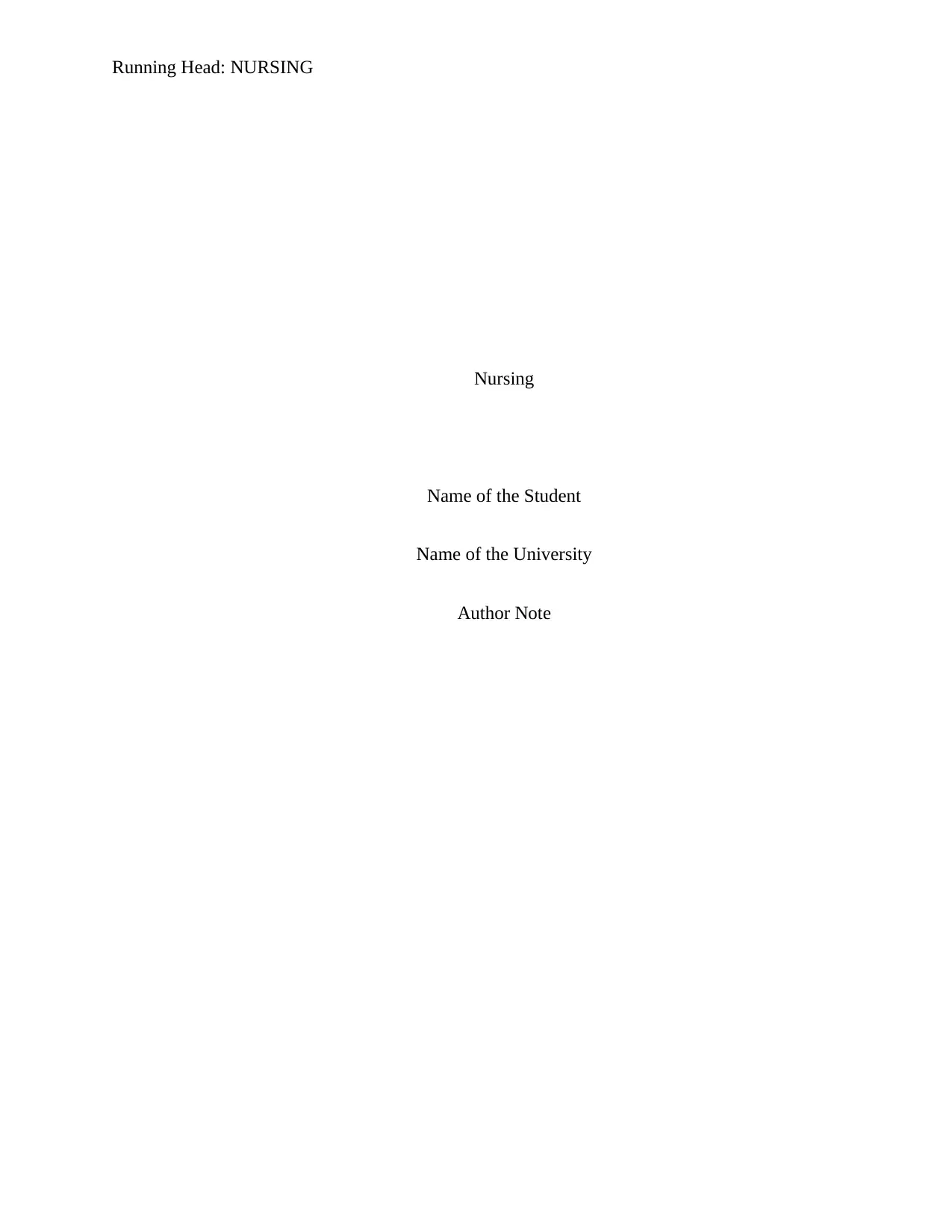
Running Head: NURSING
Nursing
Name of the Student
Name of the University
Author Note
Nursing
Name of the Student
Name of the University
Author Note
Paraphrase This Document
Need a fresh take? Get an instant paraphrase of this document with our AI Paraphraser

1NURSING
Introduction
Developing the person centered care culture requires practice development. Practice
development is the creative methodology. It is the person-centered design that bridges the gap
between the rhetoric and the practice of values and culture. Practice development is the
continuous process of developing the evidenced based cultures (Laird et al. 2015). It is
challenging to implement the evidenced based practice, as it is uncomfortable to adapt to
changes on a daily basis. However, the dynamics of the health industry is changing continuously
and demands a change in the practice development. One of the effective tools in practice
development is the wadula puzzling cube, which will be used in this assignment (Walsh et al.
2008). The assignment deals with the clinical issue that is identified form personal practice
experience in native country, Australia.
Identifying the issue and Purpose
When I was placed as clinical nurse in the reputed hospital of Melbourne, the fall of
older adults was a prominent issue. Patients fall in the aged care is the burning issue among the
health care workers. It is challenging to obtain the “zero falls goals”. To obtain this goal the staff
nurses are directly responsible as they are frontline carers for older adult patients. The increasing
rate of falls and the fall prevention message add stress to nurses. They develop a fear of falls and
must be careful for protecting the self along with unit. They also must restrict the fall risk
patients (Burns et al. 2016).
To meet the hospital goals and to stop the fall prevention messages or alerts, there is need
of identifying the barriers to prevention. To implement the fall prevention strategies, there is a
Introduction
Developing the person centered care culture requires practice development. Practice
development is the creative methodology. It is the person-centered design that bridges the gap
between the rhetoric and the practice of values and culture. Practice development is the
continuous process of developing the evidenced based cultures (Laird et al. 2015). It is
challenging to implement the evidenced based practice, as it is uncomfortable to adapt to
changes on a daily basis. However, the dynamics of the health industry is changing continuously
and demands a change in the practice development. One of the effective tools in practice
development is the wadula puzzling cube, which will be used in this assignment (Walsh et al.
2008). The assignment deals with the clinical issue that is identified form personal practice
experience in native country, Australia.
Identifying the issue and Purpose
When I was placed as clinical nurse in the reputed hospital of Melbourne, the fall of
older adults was a prominent issue. Patients fall in the aged care is the burning issue among the
health care workers. It is challenging to obtain the “zero falls goals”. To obtain this goal the staff
nurses are directly responsible as they are frontline carers for older adult patients. The increasing
rate of falls and the fall prevention message add stress to nurses. They develop a fear of falls and
must be careful for protecting the self along with unit. They also must restrict the fall risk
patients (Burns et al. 2016).
To meet the hospital goals and to stop the fall prevention messages or alerts, there is need
of identifying the barriers to prevention. To implement the fall prevention strategies, there is a

2NURSING
need of strong evidence on the factors causing fall and consensus on the set of questions that will
determine the readiness for change. There is rich evidence on the fall prevention strategies.
However, there is limited evidence on the factors that is preventing the staff to be ready for
change. I the hospital it was observed that fall prevention protocol was already in place, but in
vain. There is limited evidence on the implementation and evaluation of the protocol.
Therefore, the purpose of the assignment is to identify what fall prevention a strategy, the
staff prefers to use. Therefore, I have developed a puzzle question, which is as follows-
“Which fall prevention practices do you want to use, that will ensure patient safety?”
The purpose of the puzzle question is to reduce the number of falls in the hospital and
unintended consequences associated with it. Being successful in addressing this question will be
beneficial to both the patient and the nurses. Solving this puzzle will help relieve the stress of the
nursing staff in my organization. The puzzle uses the CIP (collaborative, inclusive, participatory)
principles as the main purpose of developing puzzle question is to improve the quality of care by
reducing falls of the older adults. It will help achieve the person centeredness and the services
provided will be of high quality, while ensuring the optimal outcomes.
No hospital can reduce all the types of falls. Every hospital have a fall pattern, which
means presence of factors that cause commonly occurring falls. It may happen that a particular
fall prevention strategy, is working in hospital X and failed to reduce falls in hospital Y. This
can be attributed to various factors such as lack of awareness among the nursing staff, lack of
regular audits, programs lacking patient evaluation, lack of appropriate training for staff. Cost
can be additional barrier behind implementing the innovative technology for fall prevention such
need of strong evidence on the factors causing fall and consensus on the set of questions that will
determine the readiness for change. There is rich evidence on the fall prevention strategies.
However, there is limited evidence on the factors that is preventing the staff to be ready for
change. I the hospital it was observed that fall prevention protocol was already in place, but in
vain. There is limited evidence on the implementation and evaluation of the protocol.
Therefore, the purpose of the assignment is to identify what fall prevention a strategy, the
staff prefers to use. Therefore, I have developed a puzzle question, which is as follows-
“Which fall prevention practices do you want to use, that will ensure patient safety?”
The purpose of the puzzle question is to reduce the number of falls in the hospital and
unintended consequences associated with it. Being successful in addressing this question will be
beneficial to both the patient and the nurses. Solving this puzzle will help relieve the stress of the
nursing staff in my organization. The puzzle uses the CIP (collaborative, inclusive, participatory)
principles as the main purpose of developing puzzle question is to improve the quality of care by
reducing falls of the older adults. It will help achieve the person centeredness and the services
provided will be of high quality, while ensuring the optimal outcomes.
No hospital can reduce all the types of falls. Every hospital have a fall pattern, which
means presence of factors that cause commonly occurring falls. It may happen that a particular
fall prevention strategy, is working in hospital X and failed to reduce falls in hospital Y. This
can be attributed to various factors such as lack of awareness among the nursing staff, lack of
regular audits, programs lacking patient evaluation, lack of appropriate training for staff. Cost
can be additional barrier behind implementing the innovative technology for fall prevention such
⊘ This is a preview!⊘
Do you want full access?
Subscribe today to unlock all pages.

Trusted by 1+ million students worldwide
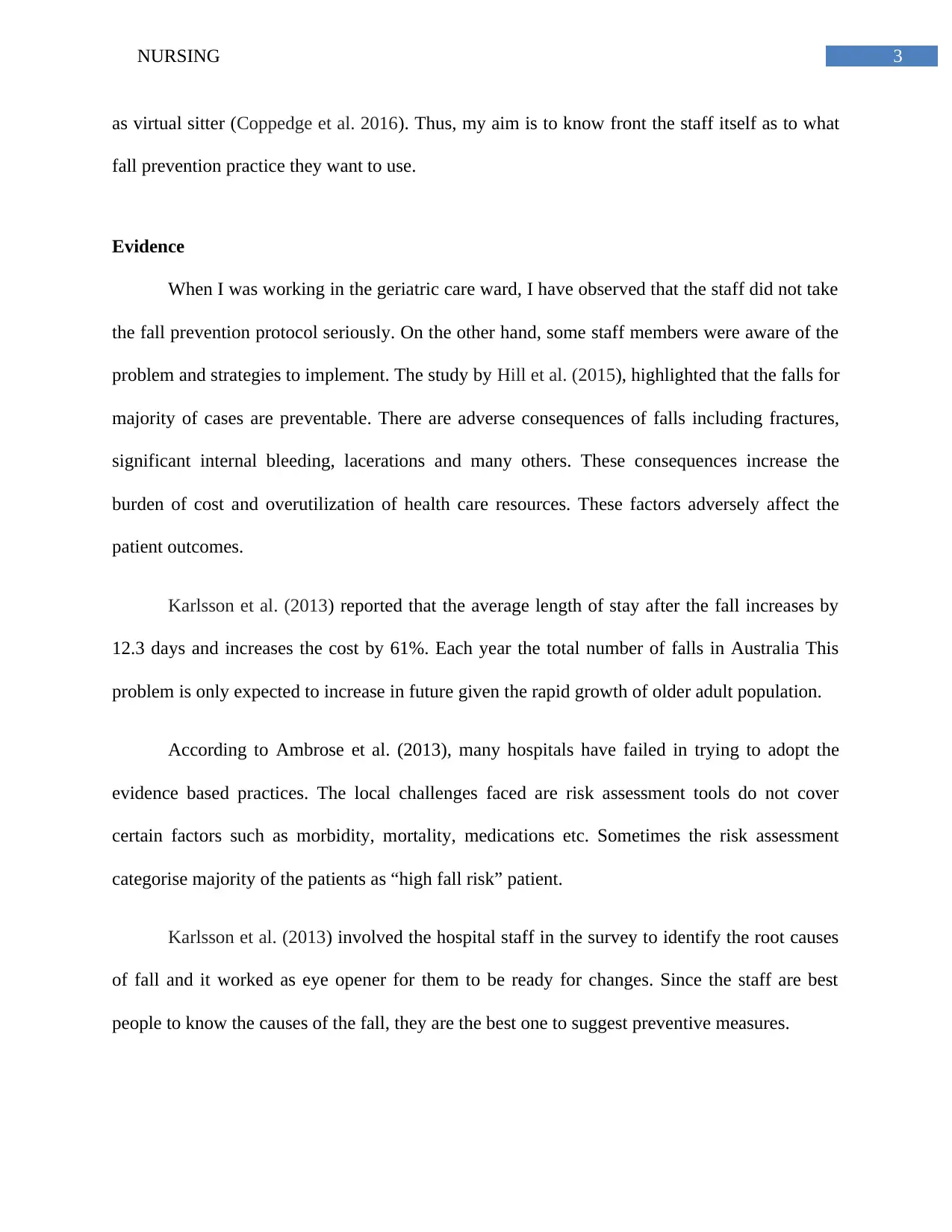
3NURSING
as virtual sitter (Coppedge et al. 2016). Thus, my aim is to know front the staff itself as to what
fall prevention practice they want to use.
Evidence
When I was working in the geriatric care ward, I have observed that the staff did not take
the fall prevention protocol seriously. On the other hand, some staff members were aware of the
problem and strategies to implement. The study by Hill et al. (2015), highlighted that the falls for
majority of cases are preventable. There are adverse consequences of falls including fractures,
significant internal bleeding, lacerations and many others. These consequences increase the
burden of cost and overutilization of health care resources. These factors adversely affect the
patient outcomes.
Karlsson et al. (2013) reported that the average length of stay after the fall increases by
12.3 days and increases the cost by 61%. Each year the total number of falls in Australia This
problem is only expected to increase in future given the rapid growth of older adult population.
According to Ambrose et al. (2013), many hospitals have failed in trying to adopt the
evidence based practices. The local challenges faced are risk assessment tools do not cover
certain factors such as morbidity, mortality, medications etc. Sometimes the risk assessment
categorise majority of the patients as “high fall risk” patient.
Karlsson et al. (2013) involved the hospital staff in the survey to identify the root causes
of fall and it worked as eye opener for them to be ready for changes. Since the staff are best
people to know the causes of the fall, they are the best one to suggest preventive measures.
as virtual sitter (Coppedge et al. 2016). Thus, my aim is to know front the staff itself as to what
fall prevention practice they want to use.
Evidence
When I was working in the geriatric care ward, I have observed that the staff did not take
the fall prevention protocol seriously. On the other hand, some staff members were aware of the
problem and strategies to implement. The study by Hill et al. (2015), highlighted that the falls for
majority of cases are preventable. There are adverse consequences of falls including fractures,
significant internal bleeding, lacerations and many others. These consequences increase the
burden of cost and overutilization of health care resources. These factors adversely affect the
patient outcomes.
Karlsson et al. (2013) reported that the average length of stay after the fall increases by
12.3 days and increases the cost by 61%. Each year the total number of falls in Australia This
problem is only expected to increase in future given the rapid growth of older adult population.
According to Ambrose et al. (2013), many hospitals have failed in trying to adopt the
evidence based practices. The local challenges faced are risk assessment tools do not cover
certain factors such as morbidity, mortality, medications etc. Sometimes the risk assessment
categorise majority of the patients as “high fall risk” patient.
Karlsson et al. (2013) involved the hospital staff in the survey to identify the root causes
of fall and it worked as eye opener for them to be ready for changes. Since the staff are best
people to know the causes of the fall, they are the best one to suggest preventive measures.
Paraphrase This Document
Need a fresh take? Get an instant paraphrase of this document with our AI Paraphraser
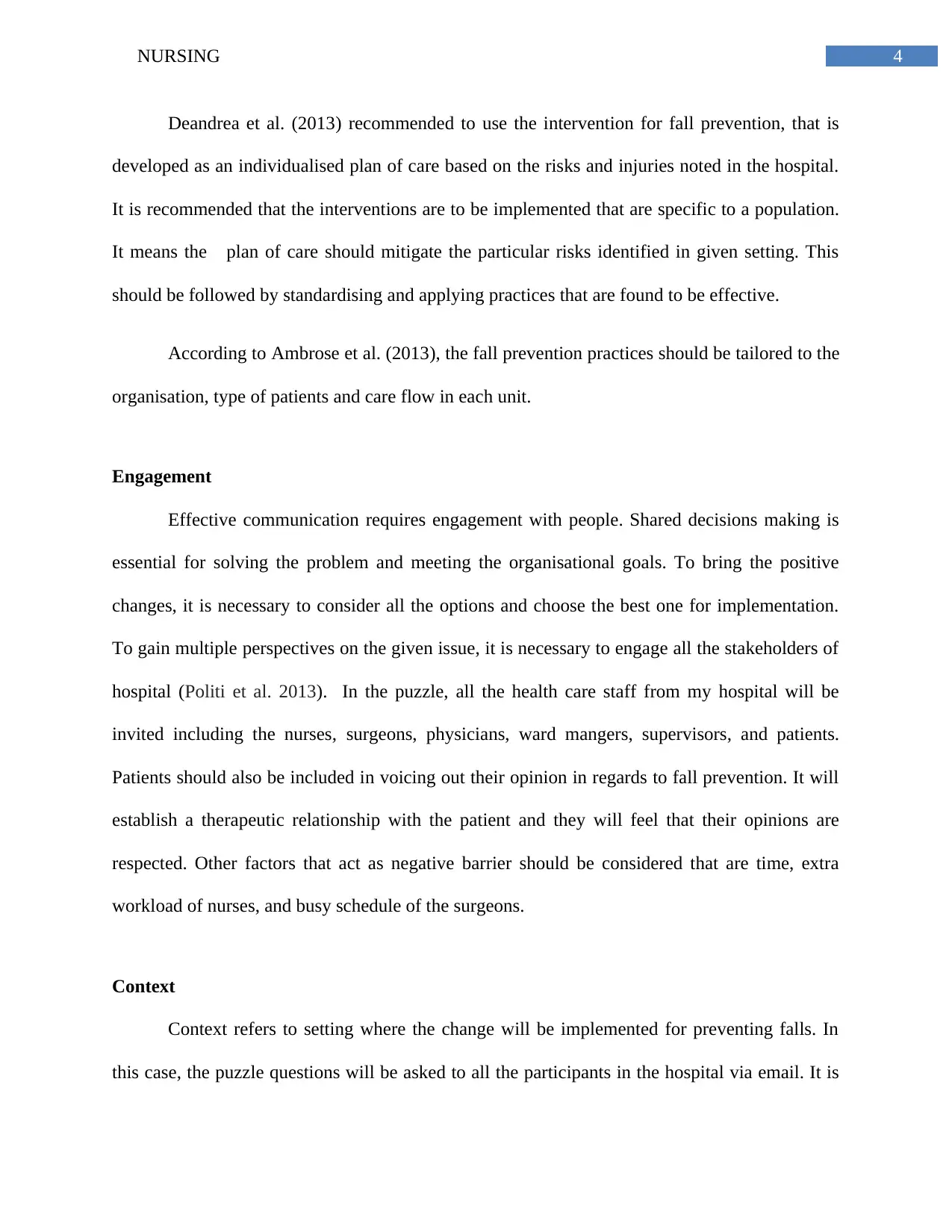
4NURSING
Deandrea et al. (2013) recommended to use the intervention for fall prevention, that is
developed as an individualised plan of care based on the risks and injuries noted in the hospital.
It is recommended that the interventions are to be implemented that are specific to a population.
It means the plan of care should mitigate the particular risks identified in given setting. This
should be followed by standardising and applying practices that are found to be effective.
According to Ambrose et al. (2013), the fall prevention practices should be tailored to the
organisation, type of patients and care flow in each unit.
Engagement
Effective communication requires engagement with people. Shared decisions making is
essential for solving the problem and meeting the organisational goals. To bring the positive
changes, it is necessary to consider all the options and choose the best one for implementation.
To gain multiple perspectives on the given issue, it is necessary to engage all the stakeholders of
hospital (Politi et al. 2013). In the puzzle, all the health care staff from my hospital will be
invited including the nurses, surgeons, physicians, ward mangers, supervisors, and patients.
Patients should also be included in voicing out their opinion in regards to fall prevention. It will
establish a therapeutic relationship with the patient and they will feel that their opinions are
respected. Other factors that act as negative barrier should be considered that are time, extra
workload of nurses, and busy schedule of the surgeons.
Context
Context refers to setting where the change will be implemented for preventing falls. In
this case, the puzzle questions will be asked to all the participants in the hospital via email. It is
Deandrea et al. (2013) recommended to use the intervention for fall prevention, that is
developed as an individualised plan of care based on the risks and injuries noted in the hospital.
It is recommended that the interventions are to be implemented that are specific to a population.
It means the plan of care should mitigate the particular risks identified in given setting. This
should be followed by standardising and applying practices that are found to be effective.
According to Ambrose et al. (2013), the fall prevention practices should be tailored to the
organisation, type of patients and care flow in each unit.
Engagement
Effective communication requires engagement with people. Shared decisions making is
essential for solving the problem and meeting the organisational goals. To bring the positive
changes, it is necessary to consider all the options and choose the best one for implementation.
To gain multiple perspectives on the given issue, it is necessary to engage all the stakeholders of
hospital (Politi et al. 2013). In the puzzle, all the health care staff from my hospital will be
invited including the nurses, surgeons, physicians, ward mangers, supervisors, and patients.
Patients should also be included in voicing out their opinion in regards to fall prevention. It will
establish a therapeutic relationship with the patient and they will feel that their opinions are
respected. Other factors that act as negative barrier should be considered that are time, extra
workload of nurses, and busy schedule of the surgeons.
Context
Context refers to setting where the change will be implemented for preventing falls. In
this case, the puzzle questions will be asked to all the participants in the hospital via email. It is
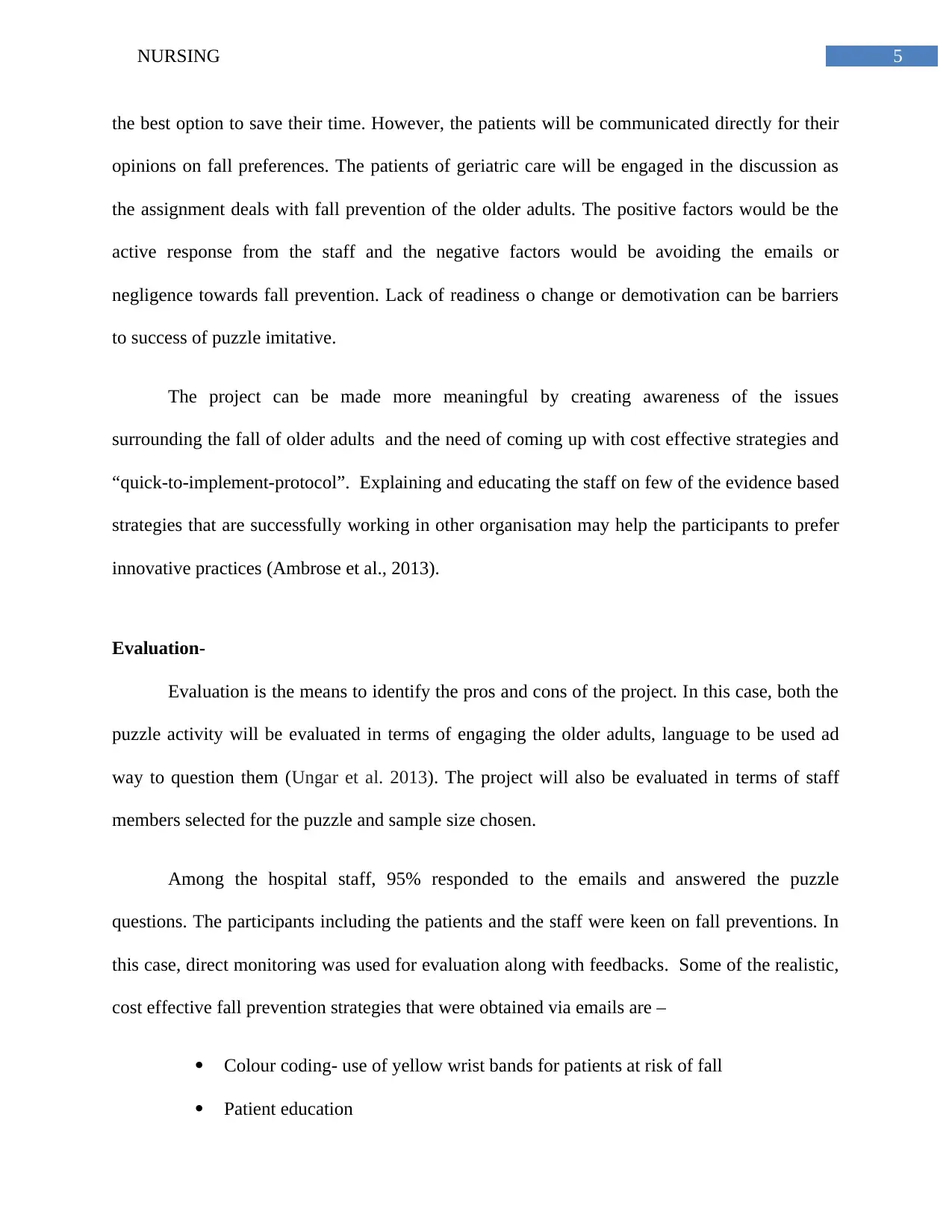
5NURSING
the best option to save their time. However, the patients will be communicated directly for their
opinions on fall preferences. The patients of geriatric care will be engaged in the discussion as
the assignment deals with fall prevention of the older adults. The positive factors would be the
active response from the staff and the negative factors would be avoiding the emails or
negligence towards fall prevention. Lack of readiness o change or demotivation can be barriers
to success of puzzle imitative.
The project can be made more meaningful by creating awareness of the issues
surrounding the fall of older adults and the need of coming up with cost effective strategies and
“quick-to-implement-protocol”. Explaining and educating the staff on few of the evidence based
strategies that are successfully working in other organisation may help the participants to prefer
innovative practices (Ambrose et al., 2013).
Evaluation-
Evaluation is the means to identify the pros and cons of the project. In this case, both the
puzzle activity will be evaluated in terms of engaging the older adults, language to be used ad
way to question them (Ungar et al. 2013). The project will also be evaluated in terms of staff
members selected for the puzzle and sample size chosen.
Among the hospital staff, 95% responded to the emails and answered the puzzle
questions. The participants including the patients and the staff were keen on fall preventions. In
this case, direct monitoring was used for evaluation along with feedbacks. Some of the realistic,
cost effective fall prevention strategies that were obtained via emails are –
Colour coding- use of yellow wrist bands for patients at risk of fall
Patient education
the best option to save their time. However, the patients will be communicated directly for their
opinions on fall preferences. The patients of geriatric care will be engaged in the discussion as
the assignment deals with fall prevention of the older adults. The positive factors would be the
active response from the staff and the negative factors would be avoiding the emails or
negligence towards fall prevention. Lack of readiness o change or demotivation can be barriers
to success of puzzle imitative.
The project can be made more meaningful by creating awareness of the issues
surrounding the fall of older adults and the need of coming up with cost effective strategies and
“quick-to-implement-protocol”. Explaining and educating the staff on few of the evidence based
strategies that are successfully working in other organisation may help the participants to prefer
innovative practices (Ambrose et al., 2013).
Evaluation-
Evaluation is the means to identify the pros and cons of the project. In this case, both the
puzzle activity will be evaluated in terms of engaging the older adults, language to be used ad
way to question them (Ungar et al. 2013). The project will also be evaluated in terms of staff
members selected for the puzzle and sample size chosen.
Among the hospital staff, 95% responded to the emails and answered the puzzle
questions. The participants including the patients and the staff were keen on fall preventions. In
this case, direct monitoring was used for evaluation along with feedbacks. Some of the realistic,
cost effective fall prevention strategies that were obtained via emails are –
Colour coding- use of yellow wrist bands for patients at risk of fall
Patient education
⊘ This is a preview!⊘
Do you want full access?
Subscribe today to unlock all pages.

Trusted by 1+ million students worldwide
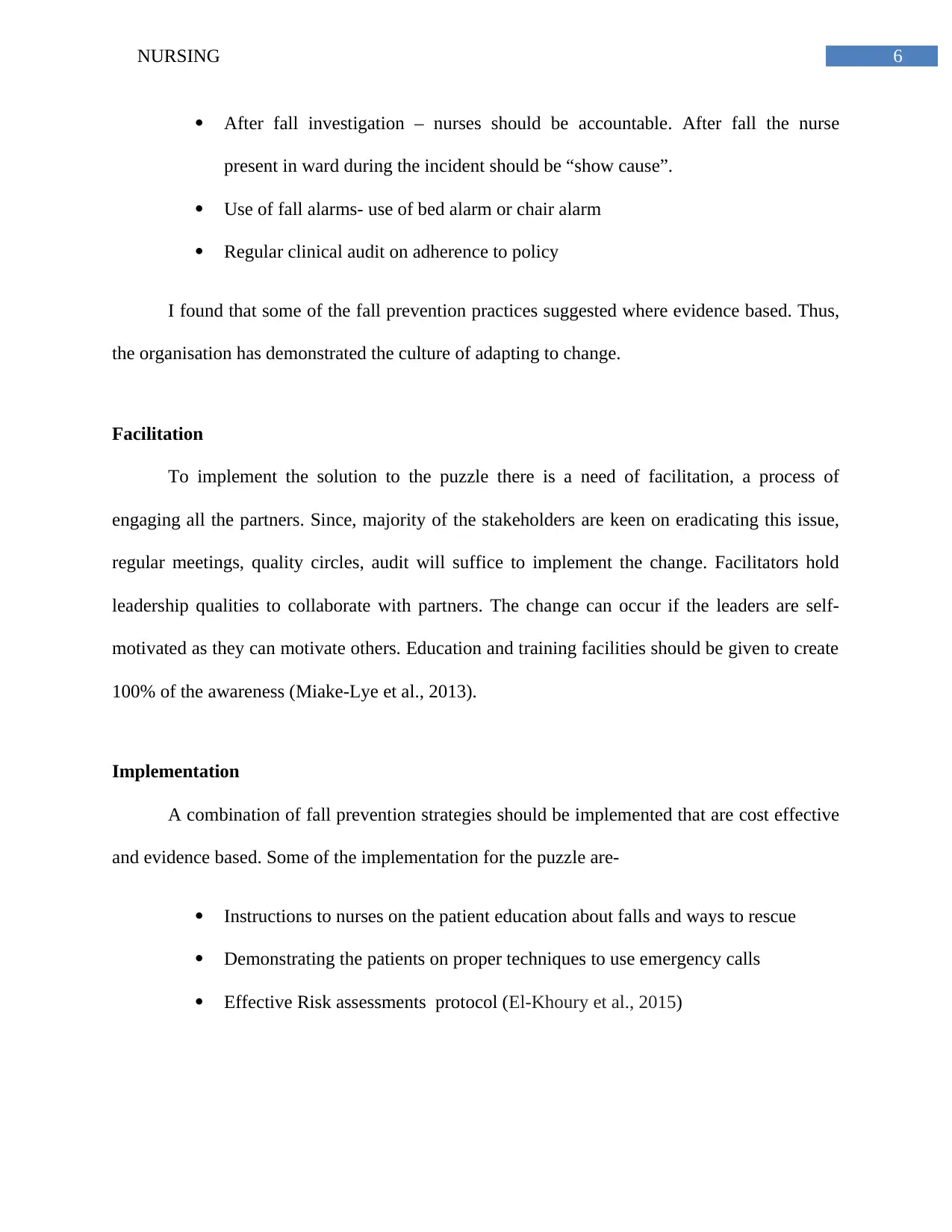
6NURSING
After fall investigation – nurses should be accountable. After fall the nurse
present in ward during the incident should be “show cause”.
Use of fall alarms- use of bed alarm or chair alarm
Regular clinical audit on adherence to policy
I found that some of the fall prevention practices suggested where evidence based. Thus,
the organisation has demonstrated the culture of adapting to change.
Facilitation
To implement the solution to the puzzle there is a need of facilitation, a process of
engaging all the partners. Since, majority of the stakeholders are keen on eradicating this issue,
regular meetings, quality circles, audit will suffice to implement the change. Facilitators hold
leadership qualities to collaborate with partners. The change can occur if the leaders are self-
motivated as they can motivate others. Education and training facilities should be given to create
100% of the awareness (Miake-Lye et al., 2013).
Implementation
A combination of fall prevention strategies should be implemented that are cost effective
and evidence based. Some of the implementation for the puzzle are-
Instructions to nurses on the patient education about falls and ways to rescue
Demonstrating the patients on proper techniques to use emergency calls
Effective Risk assessments protocol (El-Khoury et al., 2015)
After fall investigation – nurses should be accountable. After fall the nurse
present in ward during the incident should be “show cause”.
Use of fall alarms- use of bed alarm or chair alarm
Regular clinical audit on adherence to policy
I found that some of the fall prevention practices suggested where evidence based. Thus,
the organisation has demonstrated the culture of adapting to change.
Facilitation
To implement the solution to the puzzle there is a need of facilitation, a process of
engaging all the partners. Since, majority of the stakeholders are keen on eradicating this issue,
regular meetings, quality circles, audit will suffice to implement the change. Facilitators hold
leadership qualities to collaborate with partners. The change can occur if the leaders are self-
motivated as they can motivate others. Education and training facilities should be given to create
100% of the awareness (Miake-Lye et al., 2013).
Implementation
A combination of fall prevention strategies should be implemented that are cost effective
and evidence based. Some of the implementation for the puzzle are-
Instructions to nurses on the patient education about falls and ways to rescue
Demonstrating the patients on proper techniques to use emergency calls
Effective Risk assessments protocol (El-Khoury et al., 2015)
Paraphrase This Document
Need a fresh take? Get an instant paraphrase of this document with our AI Paraphraser
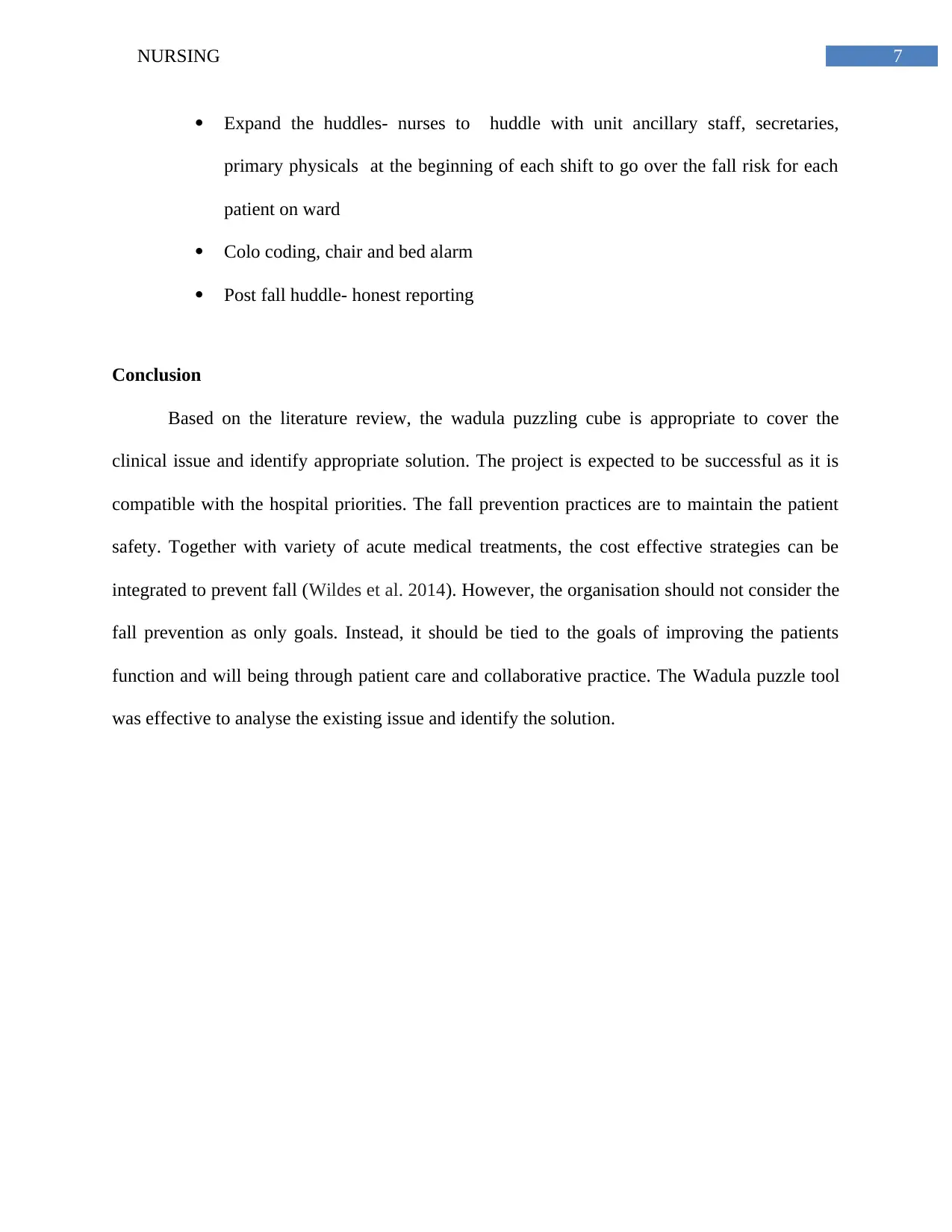
7NURSING
Expand the huddles- nurses to huddle with unit ancillary staff, secretaries,
primary physicals at the beginning of each shift to go over the fall risk for each
patient on ward
Colo coding, chair and bed alarm
Post fall huddle- honest reporting
Conclusion
Based on the literature review, the wadula puzzling cube is appropriate to cover the
clinical issue and identify appropriate solution. The project is expected to be successful as it is
compatible with the hospital priorities. The fall prevention practices are to maintain the patient
safety. Together with variety of acute medical treatments, the cost effective strategies can be
integrated to prevent fall (Wildes et al. 2014). However, the organisation should not consider the
fall prevention as only goals. Instead, it should be tied to the goals of improving the patients
function and will being through patient care and collaborative practice. The Wadula puzzle tool
was effective to analyse the existing issue and identify the solution.
Expand the huddles- nurses to huddle with unit ancillary staff, secretaries,
primary physicals at the beginning of each shift to go over the fall risk for each
patient on ward
Colo coding, chair and bed alarm
Post fall huddle- honest reporting
Conclusion
Based on the literature review, the wadula puzzling cube is appropriate to cover the
clinical issue and identify appropriate solution. The project is expected to be successful as it is
compatible with the hospital priorities. The fall prevention practices are to maintain the patient
safety. Together with variety of acute medical treatments, the cost effective strategies can be
integrated to prevent fall (Wildes et al. 2014). However, the organisation should not consider the
fall prevention as only goals. Instead, it should be tied to the goals of improving the patients
function and will being through patient care and collaborative practice. The Wadula puzzle tool
was effective to analyse the existing issue and identify the solution.
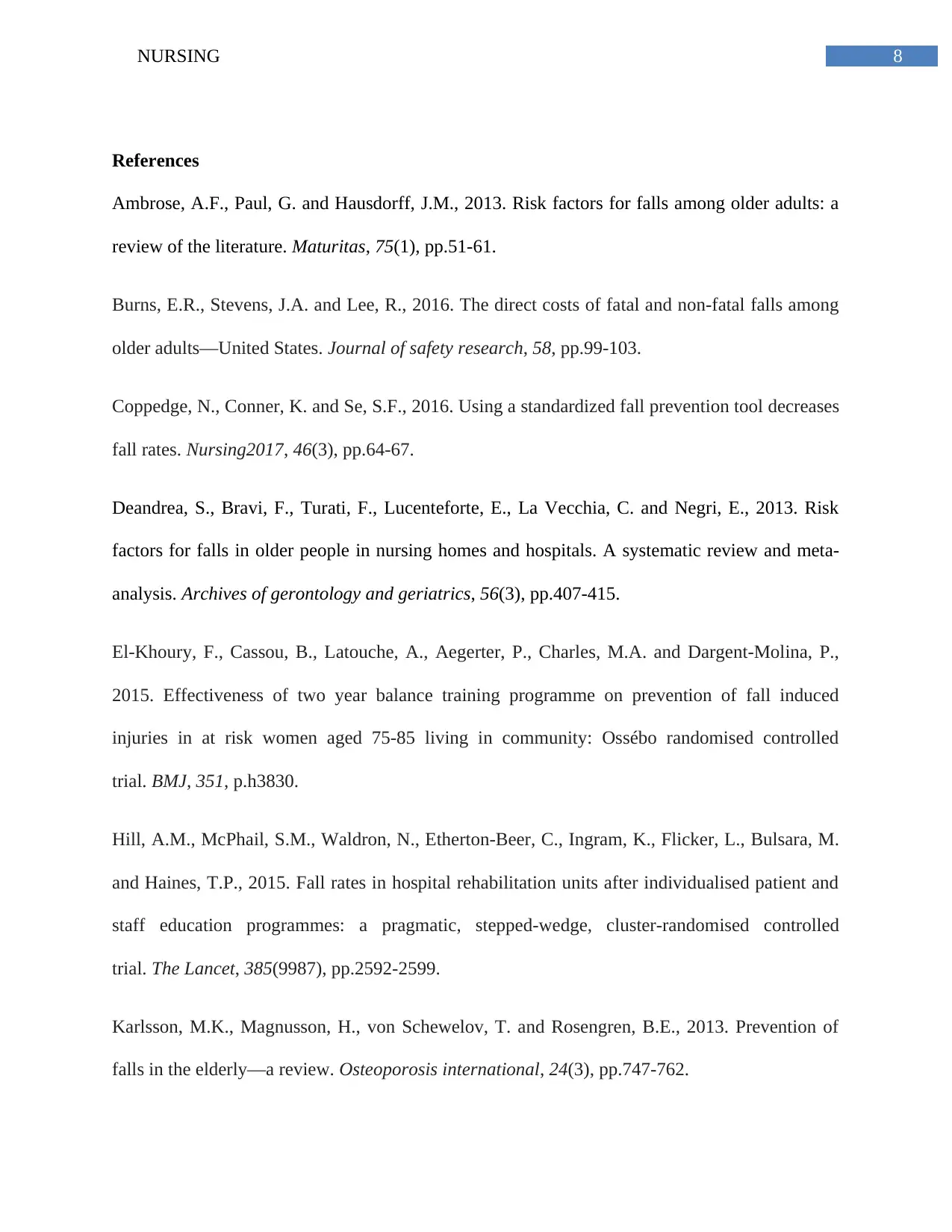
8NURSING
References
Ambrose, A.F., Paul, G. and Hausdorff, J.M., 2013. Risk factors for falls among older adults: a
review of the literature. Maturitas, 75(1), pp.51-61.
Burns, E.R., Stevens, J.A. and Lee, R., 2016. The direct costs of fatal and non-fatal falls among
older adults—United States. Journal of safety research, 58, pp.99-103.
Coppedge, N., Conner, K. and Se, S.F., 2016. Using a standardized fall prevention tool decreases
fall rates. Nursing2017, 46(3), pp.64-67.
Deandrea, S., Bravi, F., Turati, F., Lucenteforte, E., La Vecchia, C. and Negri, E., 2013. Risk
factors for falls in older people in nursing homes and hospitals. A systematic review and meta-
analysis. Archives of gerontology and geriatrics, 56(3), pp.407-415.
El-Khoury, F., Cassou, B., Latouche, A., Aegerter, P., Charles, M.A. and Dargent-Molina, P.,
2015. Effectiveness of two year balance training programme on prevention of fall induced
injuries in at risk women aged 75-85 living in community: Ossébo randomised controlled
trial. BMJ, 351, p.h3830.
Hill, A.M., McPhail, S.M., Waldron, N., Etherton-Beer, C., Ingram, K., Flicker, L., Bulsara, M.
and Haines, T.P., 2015. Fall rates in hospital rehabilitation units after individualised patient and
staff education programmes: a pragmatic, stepped-wedge, cluster-randomised controlled
trial. The Lancet, 385(9987), pp.2592-2599.
Karlsson, M.K., Magnusson, H., von Schewelov, T. and Rosengren, B.E., 2013. Prevention of
falls in the elderly—a review. Osteoporosis international, 24(3), pp.747-762.
References
Ambrose, A.F., Paul, G. and Hausdorff, J.M., 2013. Risk factors for falls among older adults: a
review of the literature. Maturitas, 75(1), pp.51-61.
Burns, E.R., Stevens, J.A. and Lee, R., 2016. The direct costs of fatal and non-fatal falls among
older adults—United States. Journal of safety research, 58, pp.99-103.
Coppedge, N., Conner, K. and Se, S.F., 2016. Using a standardized fall prevention tool decreases
fall rates. Nursing2017, 46(3), pp.64-67.
Deandrea, S., Bravi, F., Turati, F., Lucenteforte, E., La Vecchia, C. and Negri, E., 2013. Risk
factors for falls in older people in nursing homes and hospitals. A systematic review and meta-
analysis. Archives of gerontology and geriatrics, 56(3), pp.407-415.
El-Khoury, F., Cassou, B., Latouche, A., Aegerter, P., Charles, M.A. and Dargent-Molina, P.,
2015. Effectiveness of two year balance training programme on prevention of fall induced
injuries in at risk women aged 75-85 living in community: Ossébo randomised controlled
trial. BMJ, 351, p.h3830.
Hill, A.M., McPhail, S.M., Waldron, N., Etherton-Beer, C., Ingram, K., Flicker, L., Bulsara, M.
and Haines, T.P., 2015. Fall rates in hospital rehabilitation units after individualised patient and
staff education programmes: a pragmatic, stepped-wedge, cluster-randomised controlled
trial. The Lancet, 385(9987), pp.2592-2599.
Karlsson, M.K., Magnusson, H., von Schewelov, T. and Rosengren, B.E., 2013. Prevention of
falls in the elderly—a review. Osteoporosis international, 24(3), pp.747-762.
⊘ This is a preview!⊘
Do you want full access?
Subscribe today to unlock all pages.

Trusted by 1+ million students worldwide
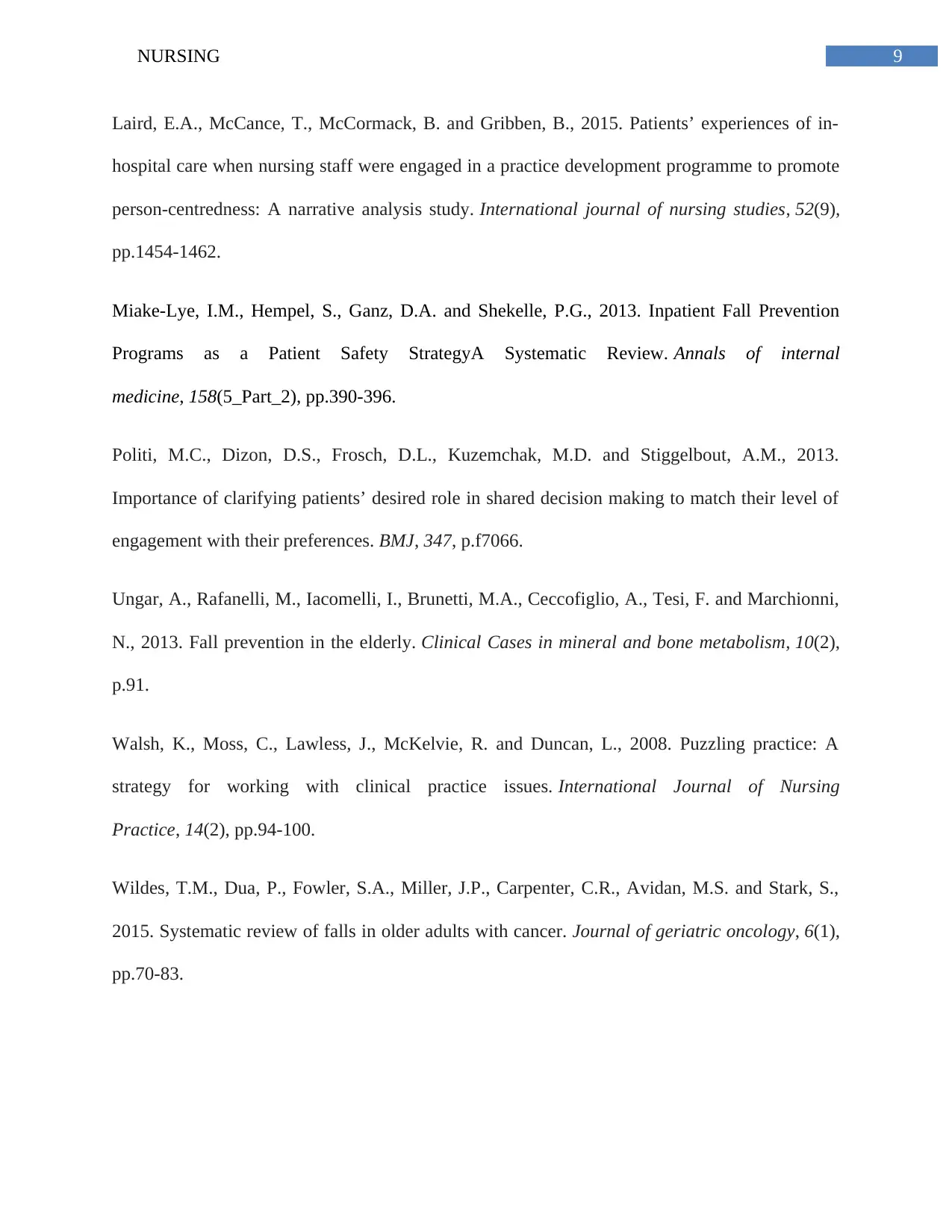
9NURSING
Laird, E.A., McCance, T., McCormack, B. and Gribben, B., 2015. Patients’ experiences of in-
hospital care when nursing staff were engaged in a practice development programme to promote
person-centredness: A narrative analysis study. International journal of nursing studies, 52(9),
pp.1454-1462.
Miake-Lye, I.M., Hempel, S., Ganz, D.A. and Shekelle, P.G., 2013. Inpatient Fall Prevention
Programs as a Patient Safety StrategyA Systematic Review. Annals of internal
medicine, 158(5_Part_2), pp.390-396.
Politi, M.C., Dizon, D.S., Frosch, D.L., Kuzemchak, M.D. and Stiggelbout, A.M., 2013.
Importance of clarifying patients’ desired role in shared decision making to match their level of
engagement with their preferences. BMJ, 347, p.f7066.
Ungar, A., Rafanelli, M., Iacomelli, I., Brunetti, M.A., Ceccofiglio, A., Tesi, F. and Marchionni,
N., 2013. Fall prevention in the elderly. Clinical Cases in mineral and bone metabolism, 10(2),
p.91.
Walsh, K., Moss, C., Lawless, J., McKelvie, R. and Duncan, L., 2008. Puzzling practice: A
strategy for working with clinical practice issues. International Journal of Nursing
Practice, 14(2), pp.94-100.
Wildes, T.M., Dua, P., Fowler, S.A., Miller, J.P., Carpenter, C.R., Avidan, M.S. and Stark, S.,
2015. Systematic review of falls in older adults with cancer. Journal of geriatric oncology, 6(1),
pp.70-83.
Laird, E.A., McCance, T., McCormack, B. and Gribben, B., 2015. Patients’ experiences of in-
hospital care when nursing staff were engaged in a practice development programme to promote
person-centredness: A narrative analysis study. International journal of nursing studies, 52(9),
pp.1454-1462.
Miake-Lye, I.M., Hempel, S., Ganz, D.A. and Shekelle, P.G., 2013. Inpatient Fall Prevention
Programs as a Patient Safety StrategyA Systematic Review. Annals of internal
medicine, 158(5_Part_2), pp.390-396.
Politi, M.C., Dizon, D.S., Frosch, D.L., Kuzemchak, M.D. and Stiggelbout, A.M., 2013.
Importance of clarifying patients’ desired role in shared decision making to match their level of
engagement with their preferences. BMJ, 347, p.f7066.
Ungar, A., Rafanelli, M., Iacomelli, I., Brunetti, M.A., Ceccofiglio, A., Tesi, F. and Marchionni,
N., 2013. Fall prevention in the elderly. Clinical Cases in mineral and bone metabolism, 10(2),
p.91.
Walsh, K., Moss, C., Lawless, J., McKelvie, R. and Duncan, L., 2008. Puzzling practice: A
strategy for working with clinical practice issues. International Journal of Nursing
Practice, 14(2), pp.94-100.
Wildes, T.M., Dua, P., Fowler, S.A., Miller, J.P., Carpenter, C.R., Avidan, M.S. and Stark, S.,
2015. Systematic review of falls in older adults with cancer. Journal of geriatric oncology, 6(1),
pp.70-83.
Paraphrase This Document
Need a fresh take? Get an instant paraphrase of this document with our AI Paraphraser

10NURSING
1 out of 11
Related Documents
Your All-in-One AI-Powered Toolkit for Academic Success.
+13062052269
info@desklib.com
Available 24*7 on WhatsApp / Email
![[object Object]](/_next/static/media/star-bottom.7253800d.svg)
Unlock your academic potential
Copyright © 2020–2025 A2Z Services. All Rights Reserved. Developed and managed by ZUCOL.



